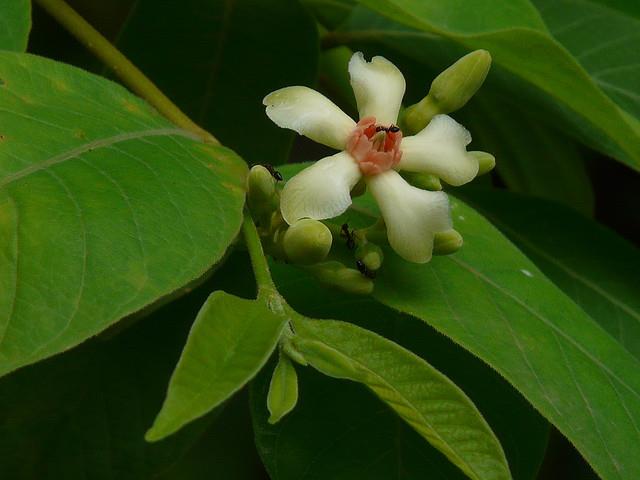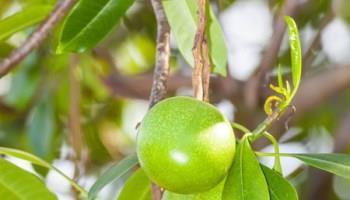KUTAJA
Contents
- Introduction
- Description of the plant
- Puranic reference
- Ayurvedic uses
Introduction
 Kutaja is the Sankrut name of a medicinal herb used to treat chronic dysentery. Kutaja is also known as Vatsaka, Kalinga, Indravruksha and Girimallika (as the flowers resemble jasmine). The plant is found in a place known as Vatsaka (Vindhya mountain range) and in Kalinga, Orissa. Thus the plant gets the name Vatsaka and Kalinga respectively. As Lord Indra restored life to the Vanaras who were killed in the battle between Lord Rama and Ravana, the plant is also known as Indravruksha.
Kutaja is the Sankrut name of a medicinal herb used to treat chronic dysentery. Kutaja is also known as Vatsaka, Kalinga, Indravruksha and Girimallika (as the flowers resemble jasmine). The plant is found in a place known as Vatsaka (Vindhya mountain range) and in Kalinga, Orissa. Thus the plant gets the name Vatsaka and Kalinga respectively. As Lord Indra restored life to the Vanaras who were killed in the battle between Lord Rama and Ravana, the plant is also known as Indravruksha.
The other vernacular names are: In Hindi (Kuda, Kora, and Kudeya Kurchi), Gujarati (Indrajav, Kado), Marathi (Pandhra Kuda), Bengali (Kudachi or Kurachi), Kannada (Kodsinge, Kodmurak), Tamil (Kutasappalai, Vēppālai), Punjabi (Kenara), Malayalam (Kudagappala) and Telugu (Kodisapala-vittulu, Kodaga). The English names are: Kurchi, Conessi tree, conessi bark and Tellichery bark. The botanical name of Kutaja is Holarrhena antidysenterica. The plant belongs to the family of Apocynacaea.
Description of the plant
Kutaja is a deciduous and spreading shrub which grows up to a height of 9- 12 meters. The stems are short and have several branches. Leaves are thick, ovate, (the leaves has a broad end towards the base) opposite and grow upto 10-20 cms in length.
 Flowers appear at the end of branches in croymb like cymes (flat topped or convex flower cluster in which the individual flower stalks grow upward from various stems). Flowers are white in colour when tender and change to creamish pale yellow as they begin to fade. Flowers have beautiful, five oblong petals and are mildly fragrant. The bark is pale greyish in colour. The fruit pod found in pairs is long, cylindrical and narrow. The fruit pod is, about 20-40 cms in length, linear to oblong and light greyish colour in colour containing 25-30 seeds per pod.
Flowers appear at the end of branches in croymb like cymes (flat topped or convex flower cluster in which the individual flower stalks grow upward from various stems). Flowers are white in colour when tender and change to creamish pale yellow as they begin to fade. Flowers have beautiful, five oblong petals and are mildly fragrant. The bark is pale greyish in colour. The fruit pod found in pairs is long, cylindrical and narrow. The fruit pod is, about 20-40 cms in length, linear to oblong and light greyish colour in colour containing 25-30 seeds per pod.
The seeds are commonly referred to as Indrayava and Sakra Bija or Vatsaka bija and Bhadrayava (meaning blessed seed).
The plant is indigenous to India and found throughout India. “Kuta” means mountains. Thus Kutaja plant is found extensively in mountain ranges.
There are two varieties of Kutaja plant:
- Pum (Black) Kutaja – Male variety – Holarrhena antidysenterica
- Stri Female)Kutaja -Female variety – Wrightea tinctoria
The White Kutaja with bitter seeds is only used for medicinal purposes.
Puranic Reference
According to Ramayana, Kutaja plant germinated from the Amrit or the nectar that fell from the bodies of the Vanaras (monkeys) who were killed in the battle between Sri Rama Sena and Ravana Sena. Lord Indra restored life to the Vanaras (monkeys). Hence the plant is known as Indrayava or Indravruksha.
In Ramayana, Lord Rama imagines offering the white flowers of the Kutaja plant to the Sun god.There is a mention of Kutaja seeds being used as water purifier in Manu Smriti. Manu Smriti also mentions Kutaja as having anti haemorrhoidal and anti pruritic properties. According to ch 10, of Devi Bhagavatam, there is a mention of Kutaja plant in Deva Loka.
In the Subala Upanishad, of Devi Bhagavatam, it is mentioned that Devi resides in Mani Dvipa, which is superior to Brahmaloka and Saravaloka. The Kutaja is found in the Mani Dvipa.
Kutaja means “born in a pitcher”. This is used with reference to Sage Agasthya who was born in a pitcher and became known for ingesting a demon and drinking the ocean.
Ayurvedic uses
The bark, seeds, flowers and fruits are used for medicinal purposes. Kutaja is one of the important medicinal plants used in the treatment of amoebic dysentery and other gastric disorders. It removes the amoeba, which otherwise could cause Liver Abscess. Kutaja is a natural remedy for chronic dysentery, diarrhoea, indigestion, flatulence, colic pain, irritable bowel syndrome cholera, and intestinal worms. Regular use of Kutaja helps in maintaining a healthy Gastro Intestinal tract and aids in the proper functioning of the colon. The plant possesses potent immune stimulant property. A concoction of Kutaja plant has both anti-diabetic and anti hyper lipidemic properties.
The decoction of the herb, along with butter milk is given to treat ano rectal problems like proctitis, painful defecation, rectal swellings etc.
Charaka in Charaka Samhita has classified the plant as one of the herbs used in the treatment of chronic dysentery, bleeding piles, useful in cleansing and detoxifying breast milk, and used as enema.
The qualities of Kutaja plant are as follows:
Rasa (taste) – Tikta (bitter), Kashaya (Astringent)
Guna (qualities) – Laghu (lightness), Rooksha (dryness)
Veerya – Sheeta – cold potency
Vipaka – Katu – Undergoes pungent taste conversion after digestion.
Effect on Tridosha – It balances Kapha and Pitta doshas.

Kutaja Bark
The bark is used as an astringent, anthelmintic, antidontalgic, stomachic, febrifuge, antidropsical, diuretic, in piles, colic, dyspepsia, skin and spleen related ailments.
Bark is used to detoxify blood, treat bleeding haemorrhoids, skin disease, intestinal worm infestation, bleeding disorders, indigestion, biliousness and diarrhoea. It is used in the treatment of cardiac associated disorders, fever, gout, herpes, quenches thirst, improves digestion, appetite and absorbs moisture during diarrhoea.
Detoxifier: The powder of the bark removes natural toxins in the body and treats the excess Pitta and Kapha doshas in the intestine.
Effect on Gastro Intestinal Tract: The bark’s astringent and cooling properties soothes the membranes of the Gastro Intestinal tract and promotes intestinal health. The powder of the bark is used to clear harmful bacteria in the gastro intestinal region of the body.
Intestinal Worms: The skin of the bark along with Vidanga seeds is a popular remedy for worm infestations in children.
Rectal problems: Kutaja powder is an anti dote for painful and rectal problems like painful defecation, rectal swelling etc.
Skin Ailments: For skin related ailments like boils or abscess or to clean the wounds, a paste of the bark powder is applied on the affected area for quick relief. The paste of the skin of the bark mixed with cow’s urine when applied topically on boils gives quick relief
Muscular tissue: Kutaja powder is used to rectify muscular tissue.
Obesity: The powder of the bark, due to its bitter taste is used to treat obesity.
Effect on intestines: For controlling stool frequency and intestinal ulcers, the powder of the Kutaja bark along with Jambu powder gives relief.
Dysentery & Diarrhoea: For treating dysentery and griping pain in the intestine (associated with dysentery), the powder of bark of Kutaja with butter milk gives relief. For diarrhoea and bleeding from stools, the powder of the bark along with Isobgol, castor oil is administered. A concoction of the powder of the bark is taken orally for treating bleeding in dysentery and diarrhoea.
Urinary stones: The skin of the bark mixed with cow’s milk is useful in treating urinary stones.
Piles: Decoction of the bark along with Sunthi, gives relief from bleeding piles. Kataju is highly beneficial in treating bleeding piles and also fever due to diarrhoea.
Rheumatoid Arthritis: The paste of the herb is applied externally for Rheumatoid Arthritis.
It is also used to stop vomiting and gout.

Kutaja Flower: Flower is used to treat skin diseases, diarrhoea, improve digestion, intestinal worm infestation and to purify blood.
The qualities of Kutaja flower are:
Rasa (taste): Tikta (Bitter) and Kashaya (Astringent)
Guna: Laghu (light)
Veerya: Sheetal (Cold potency)
Effect on tridosha- It balances Kapha and Pitta doshas
Kutaja Fruit: Kutaja fruit is used in the treatment of fever, skin ailments, herpes, abdominal colic pain, gout and piles. It is also useful in the improvement of digestion and removes impurities from blood.
The qualities of the Kutaja fruit are:
Rasa (Taste) –Tiktha (Bitter)
Veerya- Not very hot
Effect on Tridosha: Balances all the three doshas
Vipaka – Katu – Undergoes bitter taste conversion after digestion.

Kutaja Seeds: Seed possess anti bilious antibacterial and anti diabetic properties. Kutaja seeds are used in the treatment of fever, herpes vomiting and diarrhoea. It is used to promote conception and for toning up vaginal tissues after delivery.
The qualities of the seeds are:
Rasa (taste) – Bitter (Titka) Katu (Pungent)
Veerya- Coolant
Balances all the three doshas
The seed powder is used to dress oozing wounds.
The decoction of the seeds along with musta (another herb) mixed with honey is used to treat excessive thirst, reduce fever, and distaste. The seeds are also used to remove excess fat, thus an anti dote for obesity.
http://www.sacred-texts.com/hin/db/bk12ch10.htm#
http://www.bric-medplant.org/caraka.php http://www.konarkindex.com/index.php/kutaja http://www.herbalcureindia.com/herbs/holarrhena-antidysenterica.htm
http://herbs.indianmedicinalplants.info/index.php/74-kutaja-holarrhena-antidysenterica
http://www.bric-medplant.org/caraka.php http://easyayurveda.com/2013/10/17/kutaja-benefits-usage-dose-side-effects-ayurveda-details/
https://www.satveda.com/p/kutaja-powder
http://www.ayurveduniversity.edu.in/newsletters/ayu/2009_4/30402.pdfhttps://venetiaansell.wordpress.com/2010/08/15/kutaja/
http://www.toxicologycentre.com/English/plants/English/kutakappala.htm
